"Through sound science and targeted actions, we can ensure the long-term persistence of our native fish species for generations to come." from Ertel et al. 2017
Article
Preservation of Native Cutthroat Trout in Northern Yellowstone
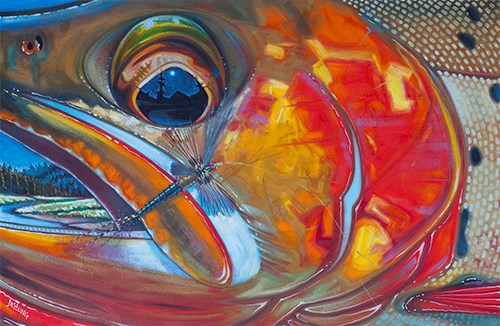
Artwork copyright Derek DeYoung
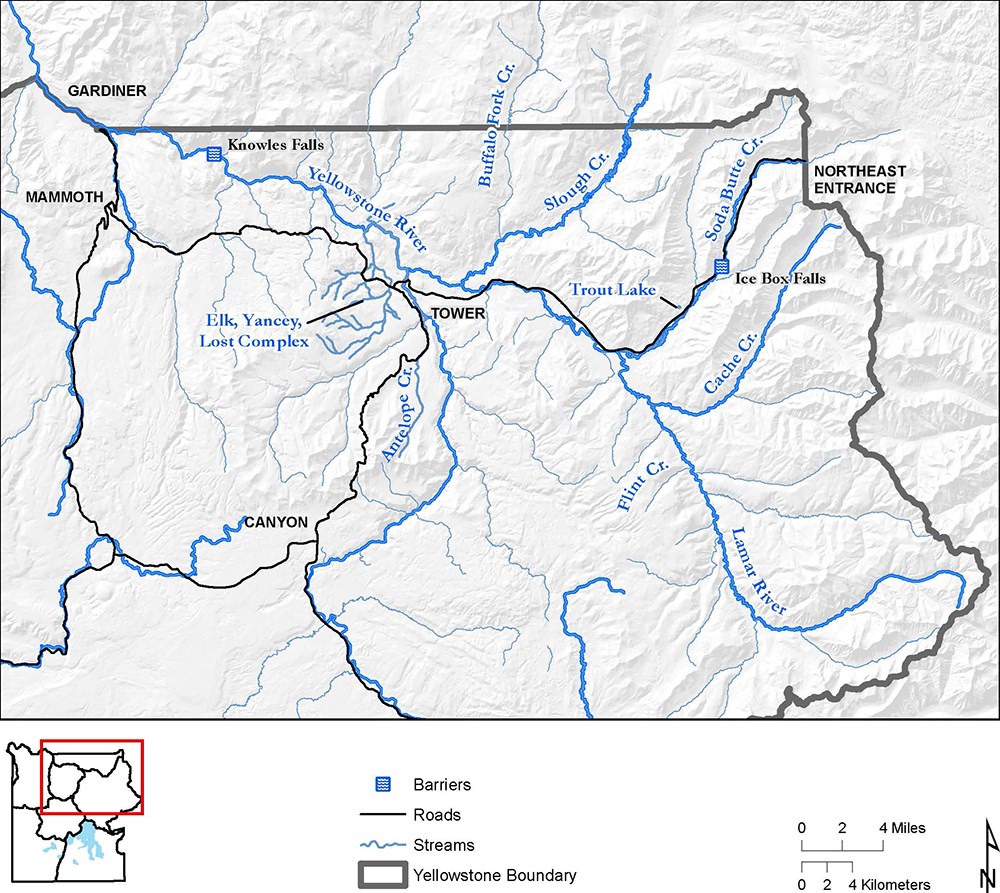
Historically, northern Yellowstone was home to native cutthroat trout, mountain whitefish, longnose dace, mottled sculpin, longnose sucker, and mountain sucker. The stocking of non-native fish began in YNP in the early 1880s to enhance sport and sustenance fishing for visitors. Many early stockings were aimed at establishing fish populations in fishless waters, and over 27 million fish were stocked in northern Yellowstone alone. Cutthroat trout accounted for about 89% of fish stocked in this region. Although most of these fish were Yellowstone cutthroat trout, in a few cases westslope cutthroat trout were stocked because a distinction was not made between the subspecies at the time. Non-native fish, including brook trout (4.4%), Arctic grayling (2.9%), rainbow trout (2.3%), and brown trout (1.9%) were also stocked in streams in northern Yellowstone.
Habitat remains pristine within YNP, but non-native fish species now reside with varying frequency in northern Yellowstone and pose a serious threat to the persistence of native fish. Brown, brook, and rainbow trout all compete with cutthroat trout for food and habitat. Rainbow trout also pose the additional threat of crossbreeding with cutthroat trout. Because of the lack of barriers in the lower reaches of the drainage, non-native fish have been dispersing upstream. In other areas, non-native fish have replaced, threaten to replace, or hybridize with cutthroat trout. Fortunately, brown trout are found only in the Yellowstone River and several of its tributaries below Knowles Falls (figure 1). Brook trout were located in the Yellowstone River and its tributaries below the Lower Falls (at Canyon) and in Soda Butte Creek upstream of Ice Box Falls. Rainbow trout are found in most waters in northern Yellowstone, with the exception of the upper reaches of Slough Creek and the Lamar River upstream of the Flint Creek confluence (figure 1). The upstream dispersal of rainbow trout and progression of hybridization with cutthroat trout continues today (figure 2). Because non-native species continue to pose the most significant threat to native fish in northern Yellowstone, the National Park Service (NPS) is taking direct actions to protect and restore native fish populations.
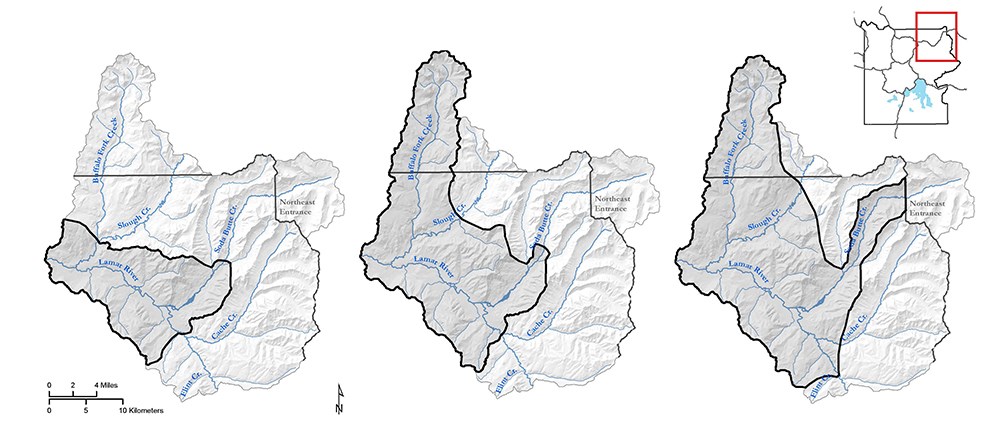
Restoration and Preservation Projects
Lamar River—Because no barriers to upstream fish migration exist in the mainstem Lamar River, descendants of rainbow trout stocked in the 1930s have spread to many locations across the watershed and hybridized with cutthroat trout. Not all has been lost, however. Genetic analysis of tissue samples collected in recent years indicate cutthroat trout in the headwater reaches of the Lamar River and Slough Creek remain genetically unaltered.
Because identification of low levels of hybridization is difficult to detect in the field, molecular genetic techniques have been employed to test for hybridization. Analysis of tissue samples collected in the Lamar River upstream of Soda Butte Creek in 2013 identified slightly hybridized fish as far upstream as the cascades by Flint Creek (figure 2). Samples at the Soda Butte Creek confluence had a rainbow trout hybridization of 2.40%; at Flint Creek, hybridization dropped to just 0.01%. Samples collected upstream of Flint Creek were genetically pure Yellowstone cutthroat trout, indicating rainbow trout have not yet invaded the upper portions of the Lamar River. However, the lack of a natural barrier in the Lamar River is a serious concern.
To protect the remaining Yellowstone cutthroat trout, the NPS has implemented a selective removal approach. A mandatory kill fishing regulation on all rainbow trout caught upstream of the Lamar River bridge was instituted in 2014 and has served to actively engage the public in conservation efforts. In addition, selective removal by electrofishing has been conducted annually through the Lamar Valley since 2013. During electrofishing events, all rainbow trout and obvious hybrid trout are removed; and native fish are returned. To-date, just 21 rainbow trout and hybrids have been removed from the system upstream of the Lamar River Canyon.
Downstream of the Lamar River Canyon, hybridized fish and rainbow trout are encountered more frequently. In 2015, in collaboration with Montana State University, 136 fish were sampled in this section of the Lamar River. Based on field identification, 48% were Yellowstone cutthroat trout, 19% were rainbow trout, and 31% were hybrids. The majority of these fish were tagged with radio transmitters or passive integrated transponder (PIT) tags as part of an ongoing research project to identify trout spawning locations. Selective removal of the non-native fish occurs annually in this river reach by electrofishing and an unlimited harvest angling regulation.
Slough Creek—In Slough Creek, rainbow-cutthroat trout hybrids have been found with increasing frequency over the past decade (figure 2). Rainbow trout and hybrids have been found in the lower reaches of Slough Creek, below Slough Creek Campground, since the 1930s, but were not officially recorded in the upper meadows until 2003. The unnamed falls and cascade located in the canyon below the first meadow were thought to be a barrier to upstream fish passage. Unfortunately, during certain flow conditions, trout are able to navigate around the margins of the falls and move into upper Slough Creek. Currently, methods used to suppress non-native trout are similar to those used in the Lamar River. However, there are differences between these systems. Slough Creek is smaller, a seasonal barrier exists, and a site has been identified to construct a complete barrier to upstream fish movement. With a barrier in place and rainbow trout no longer allowed passage into the system, existing rainbow and hybrid trout can be effectively managed with angling and electrofishing removal.
Angling and electrofishing removal efforts appear to have decreased the percentage of rainbow and hybrid trout in Slough Creek. In 2012, the percentage of rainbow and hybrid trout captured in the first and third meadows was 14% and 4%, respectively. In 2015, those percentages decreased to just 0% and 1.6%, respectively. The percentage of rainbow and hybrid trout in the second meadow, which was not electrofished prior to 2015 because of logistical constraints, was the highest of the three meadows at 6.9%, down from 8% in 2015. These results demonstrate electrofishing and angling have been an effective combination in decreasing the percentage of rainbow and hybrid trout in this drainage.
Soda Butte Creek—Brook trout became established in Soda Butte Creek outside of the park boundary in the 1980s and, over time, spread downstream into park waters. Initially, brook trout were isolated in headwater reaches by a chemical barrier created from the McClaren Mine tailings located along the river upstream of Cooke City, Montana. When the tailings were removed, brook trout passed downstream and began to negatively impact the cutthroat trout. It is well known brook trout will negatively impact native trout (Peterson et al. 2004, Shepard 2004). Thus the progression of brook trout caused great concern and compromised the security of the cutthroat trout throughout the entire Lamar River system. Mitigation of brook trout by annual interagency electrofishing surveys began in the 1990s, shortly after they were discovered downstream of Cooke City. To-date, no brook trout have been found in Soda Butte Creek downstream of Ice Box Falls.
A mandatory kill angling regulation for brook and rainbow trout and annual electrofishing removals have been used to control the number of non-native fish in Soda Butte Creek. Since the early 1990s, a cooperative work group consisting of the NPS; Montana Fish, Wildlife & Parks; Forest Service; and Wyoming Game and Fish have conducted electrofishing removals annually. In addition, rotenone treatment of Lulu Creek, a headwater tributary of Soda Butte Creek, was conducted in 2004 to eliminate the primary spawning population of brook trout in the system (Montana Fish, Wildlife & Parks 2004). Brook trout in Lulu Creek were eliminated by the treatment; however, subsequent surveys indicated brook trout had already spread downstream in the mainstem of Soda Butte Creek and other tributaries.
For nearly two decades, the interagency efforts were enough to prevent the brook trout from expanding in abundance but not in range. An average of 133 (range 48-230) brook trout were removed annually from 2006-2014. Over time, brook trout spread downstream and became a threat to the Lamar River. In addition, rainbow trout hybridization continued to be identified in cutthroat trout upstream of Ice Box Falls. It was determined that to entirely eliminate the threat of non-native fish, the falls would need modification to be a complete barrier to upstream passage and a rotenone treatment of the entire system upstream of the falls would be necessary (Montana Fish, Wildlife & Parks 2015).
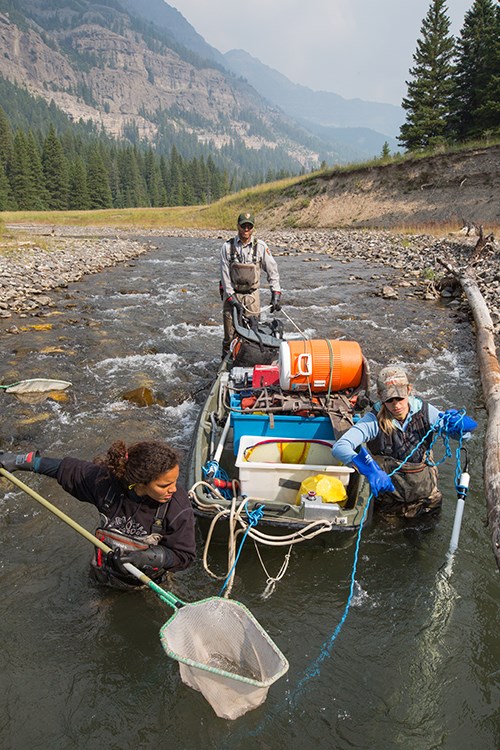
NPS Photo - N. Herbert
Elk Creek Complex—A natural cascade barrier is located in Elk Creek just upstream from its confluence with the Yellowstone River (figure 1). Because the cascade prevented fish from naturally populating the system, the Elk, Lost, and Yancey creeks complex of streams (Elk Creek Complex) was naturally fishless when first stocked with cutthroat trout in the early 1920s (Varley 1980). In 1942, the streams were stocked with brook trout, eventually resulting in the complete loss of cutthroat trout. Because of the close proximity of this stream system to the Lamar River/Yellowstone River confluence (figure 1), it was determined that brook trout should be removed. Because of the lack of any native fish in the system, the presence of a complex habitat, and the existing cascade barrier, it was decided a rotenone treatment was the best way to completely remove brook trout.
The Elk Creek Complex was treated with rotenone annually from 2012 to 2014. Electrofishing surveys conducted following each treatment revealed low numbers of brook trout remained in the system until spring 2015. Electrofishing surveys conducted in 2015 did not detect any brook trout, and water samples collected in spring and autumn contained no fish DNA. Because of its close proximity, similarity of habitat, and ease of access from the road, Antelope Creek (figure 1) was selected to be the source of fish for stocking the Elk Creek Complex. Reintroduction of genetically pure Yellowstone cutthroat trout began in October 2015, with the transfer of approximately 450 fish of varied age classes. Additional stocking of cutthroat trout and eyed-eggs (embryos) using remote site incubators will take place in future years. Cutthroat trout monitoring will occur to track recovery.
Future Yellowstone Cutthroat Trout Conservation
Protection of genetically unaltered cutthroat trout will continue to be a top priority in Yellowstone. As the global climate shifts, high-elevation headwater stream reaches may become critically important cold water refugia for salmonids, including Yellowstone cutthroat trout (Isaak et al. 2015). Furthermore, the spread of hybridization may be exacerbated as flow and temperature conditions become more favorable for rainbow trout (Muhlfeld et al. 2014). Currently, brook trout and rainbow trout pose the most immediate threat to cutthroat trout in northern Yellowstone, and they must be suppressed to ensure the long-term persistence of the Yellowstone cutthroat trout subspecies in this region.
Projects to eliminate or control brook trout and rainbow trout are in varying stages of development and implementation in northern Yellowstone. Stream project priorities are determined using criteria in the Native Fish Conservation Plan (Koel et al. 2010). This plan calls for non-native fish to be removed or reduced in streams when they directly or indirectly impact native fish species and where control is possible. Streams where suppression or complete removal of non-native fish may occur in northern Yellowstone include, but are not limited to, the Lamar River, Slough Creek, Soda Butte Creek, Buffalo Fork, Blacktail Deer Creek, and Tower Creek.
Prior to any management actions taking place, preliminary research on a stream or stream network must be completed to identify the biological implications of management actions. Within the Lamar River watershed, a research project was initiated in 2015 to better understand the distribution, dynamics, and source of rainbow trout introgression. Genetic sampling is being used to map the current distribution of rainbow trout introgression. From this information, sources of rainbow trout and locations of genetically unaltered Yellowstone cutthroat trout will be identified. Radio telemetry and PIT tags are also being used to help identify differences in the behavior and movements of cutthroat, rainbow, and hybrid trout. The information collected in this study will help identify when and where hybridization is occurring, and will determine locations and time periods when rainbow trout and hybrids may be more susceptible to electrofishing, angling, and other suppression efforts. Collectively, the results of the study will help guide management actions in the Lamar River watershed in the most effective manner, based on the unique biology and dynamics in the system.
Buffalo Fork Creek, a tributary of Slough Creek (figures 1 and 2), is a large, remote watershed that was stocked with rainbow trout in the 1930s. Today, Buffalo Fork Creek is suspected of being a significant contributor of rainbow trout to lower Slough Creek and the
Lamar River.
Similarly, Tower Creek, a tributary of the Yellowstone River, was historically stocked with brook, rainbow, and cutthroat trout. Now, brook and rainbow trout are considered a serious threat to the native cutthroat trout of the Yellowstone and Lamar river systems. Preliminary investigations are being conducted on Tower Creek and Buffalo Fork Creek to determine the feasibility of removing brook, rainbow, and hybrid trout from the systems. In the coming years, all waters in each watershed will be mapped, including mainstem creeks, tributaries, springs, seeps, lakes, ponds, and wet meadows. Potential barriers to fish migration will be identified. The upper extent of fish distribution and densities of fish will be determined by electrofishing surveys conducted throughout the watersheds. From this information, the feasibility of mechanical or chemical removals of non-native fish will be determined. While this work is occurring, potential source populations of native cutthroat trout for reintroductions will be identified and tested for genetic purity and lack of disease.
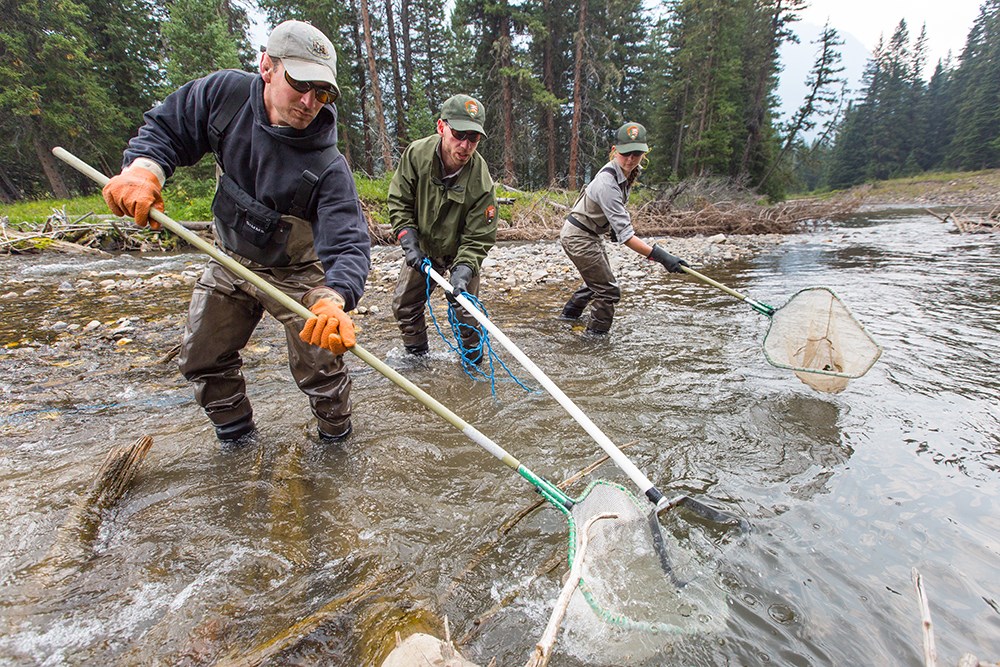
NPS Photo - N. Herbert
The northern portion of YNP offers a unique opportunity to preserve and restore native fish populations. As native fish populations in other areas become more fragmented by human activity, inundated by non-native species, and genetically compromised, pristine headwaters and protected areas such as those found in Yellowstone will become increasingly important for the long-term persistence of native species. Unless management actions are taken, non-native fish will continue to exert pressure on native fish populations through competition, predation, and hybridization. By following the adaptive management protocols set forth in the Native Fish Conservation Plan, carefully researching each potential project, and carrying out projects when native fish are being impacted, we can preserve and expand on their current range. Through sound science and targeted actions, we can ensure the long-term persistence of our native fish species for generations to come.
Literature Cited
Campbell, M.R., C.C. Kozfkay, K.A. Meyer, M.S. Powell, and R.N. Williams. 2011. Historical influences of volcanism and glaciation in shaping mitochondrial DNA variation and distribution in Yellowstone cutthroat trout across its native range. Transactions of the American Fisheries Society 140:91-107.
Ertel, B.D. 2011. Distribution, movements, and life-history characteristics of Yellowstone cutthroat trout, Oncorhynchys clarkii bouvieri, in the upper Yellowstone River drainage. Thesis. Montana State University, Bozeman, Montana, USA.
Fausch K.D., and M.K. Young. 1995. Evolutionarily significant units and movement of resident stream fishes: a cautionary tale. American Fisheries Society Symposium 17:360-370.
Fausch, K.D., C.E. Torgersen, C.V. Baxter, and H.W. Li. 2002. Landscapes to riverscapes: bridging the gap between research and conservation of stream fishes. Bioscience 52:483-498.
Gresswell, R.E., W.J. Liss, and G.L. Larson. 1994. Life-history organization of Yellowstone cutthroat trout (Oncorhynchus clarki bouvieri) in Yellowstone Lake. Canadian Journal of Fisheries and Aquatic Science 51:298-309.
High, B., D. Garren, G. Schoby, and J. Buelow. 2015. Fishery management investigations: Upper Snake River Region, 2013. Fishery management annual report IDFG 15-108. Idaho Fish and Game, Boise, Idaho, USA.
Isaak, D.J., M.K. Young, D.E. Nagel, D.L. Horan, and M.C. Groce. 2015. The cold-water climate shield: delineating refugia for preserving salmonid fishes through the 21st century. Global Change Biology 21:2540-2553.
Jones, R.D., D.G. Carty, R.E. Gresswell, C.J. Hudson, L.D. Lentsch, and D.L. Mahony. 1986. Fishery and aquatic management program technical report for calendar year 1985. U.S. Fish and Wildlife Service, Yellowstone National Park, Wyoming, USA.
Koel, T.M., J.L. Arnold, P.E. Bigelow, and M.E. Rhul. 2010. Native fish conservation plan. Environmental assessment, December 16, 2010. National Park Service, U.S. Department of the Interior, Yellowstone National Park, Wyoming, USA.
Montana Fish, Wildlife & Parks. 2004. Yellowstone cutthroat trout recovery project in Soda Butte Creek. Environmental assessment. Region 5, Billings, Montana, USA.
Montana Fish, Wildlife & Parks. 2015. Soda Butte Creek Yellowstone cutthroat trout conservation project. Environmental assessment. Region 5, Billings, Montana, USA.
Peterson, D.P., K.D. Fausch, and G.C. White. 2004. Population ecology of an invasion: effects of brook trout on native cutthroat trout. Ecological Applications 14:754-772.
Shepard, B.B. 2004. Factors that may be influencing nonnative brook trout invasion and their displacement of native westslope cutthroat trout in three adjacent southwestern Montana streams. North American Journal of Fisheries Management 24:1088-1100.
Varley, J.D. 1980. A history of fish stocking activities in Yellowstone National Park between 1881 and 1980. Information paper 35. Department of the Interior, National Park Service, Yellowstone National Park, Wyoming, USA.
Woolnough, D.A., J.A. Downing, and T.J. Newton. 2009. Fish movement and habitat use depends on water body size and shape. Ecology of Freshwater Fish 18:83-91.
_________________________________________________________________________
Brian Ertel began his career with the Yellowstone Fisheries and Aquatic Sciences Section in 1996 as a Student Conservation Association volunteer. He was hired on as a seasonal biological science technician in spring of 1997 and a year-round technician in autumn of that year. He received his BS in 1996 from Kutztown University, PA, and MS from Montana State University in 2011. He currently serves as a fisheries restoration biologist for the Yellowstone Center for Resources, Native Fish Conservation Program, focusing on Yellowstone cutthroat trout restoration and preservation.
Brian Ertel began his career with the Yellowstone Fisheries and Aquatic Sciences Section in 1996 as a Student Conservation Association volunteer. He was hired on as a seasonal biological science technician in spring of 1997 and a year-round technician in autumn of that year. He received his BS in 1996 from Kutztown University, PA, and MS from Montana State University in 2011. He currently serves as a fisheries restoration biologist for the Yellowstone Center for Resources, Native Fish Conservation Program, focusing on Yellowstone cutthroat trout restoration and preservation.
Part of a series of articles titled Yellowstone Science - Volume 25 Issue 1: Native Fish Conservation.
Tags
- yellowstone national park
- fish
- science
- research
- conservation
- yellowstone
- ycr
- yellowstone center for resources
- native fish
- native fish conservation
- ys-25-1
- cutthroat trout
- brian d. ertel
- kurt c. heim
- jeffrey l. arnold
- colleen r. detjens
- todd m. koel
- yellowstone river
- mountain whitefish
- longnose dace
- mottled sculpin
- longnose sucker
- mountain sucker
- brook trout
- arctic grayling
- rainbow trout
- brown trout
- habitat
- lamar river
- restoration
- preservation
- yellowstone cutthroat trout
- soda butte creek
- slough creek
- buffalo fork creek
- tower creek
- electrofishing
- elk creek complex
Last updated: July 26, 2017
